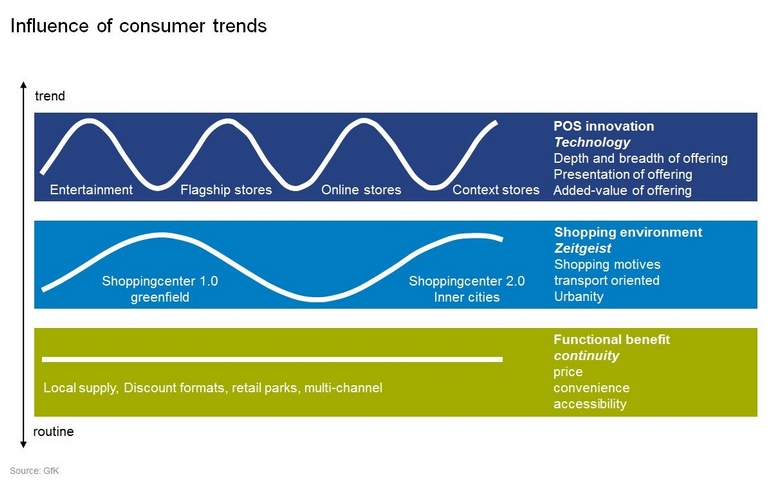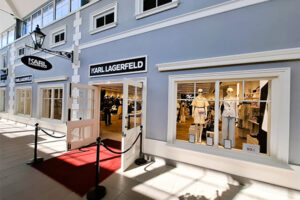BY MANUEL JAHN
Incessant structural change in the retail sector has always led to the flourishing of new concepts while driving others – sometimes slowly, sometimes almost overnight – out of the market. Shifts in sales in e-commerce are of course strengthening and accelerating competitive pressures and adjustments now have to be made not in decades, but, at most, in years. Nevertheless, the weight of various factors within the stationary trade itself is much more important. In other words: In our view, bricks-and-mortar retail has its destiny in its own hands.
Clear market positioning necessary
Knowing one’s market position requires understanding the segment in which a company is active and the various challenges it faces. Along these lines, four elements are of essential importance:
- designation as a functional shopping or entertainment shopping destination
- consideration of the various consumer types
- impact of short- and long-term consumer trends
- extent of the threat from online retail
Functional vs. entertainment shopping
A consideration of shopping behavior must take into account the entire process from the initial interest to the purchase and acquisition of the product. The intermediary stage of this so-called “customer journey” is the deliberation process, which entails gathering and weighing information. It’s often assumed that purchase decisions consist of rational, goal-oriented steps in which consumers optimally utilize all available channels and ultimately select the option that offers the best value for money. When it comes to the customer journey, much stock is placed in the ability of multi-channel strategies to drive success. But the truth is that many purchases are not motivated by rational processes.
On the one hand, items related to daily needs, such as groceries, beverages and drugstore products, are part of a very routinized customer journey, because consumers tend to shop for the same products day in and day out. That is why the online share of grocery retail is so low despite a high degree of innovation. Routines related to daily needs shopping have remained virtually unchanged in Germany for decades.
On the other hand, consumers are willing to make non-rational purchase decisions if products offer additional usages that go beyond mere functionality. Successful shop concepts are those that create point-of-sale conditions that inspire consumers to abandon their rational considerations for purchases. Consumers are aware that they are buying, but not why they are doing so. Decisions to purchase are driven by largely unconscious emotions when shopping environments stimulate the senses through smells, colors, sounds and spaces or a well-trained sales staff. When it comes to entertainment shopping, consumers’ emphasis shifts from conventional goal-orientated shopping and price comparisons to the desire to be stimulated, to look around, to engage sales staff in conversation and to interact with products.
Today’s store product lines and concepts thus vacillate between goal-oriented and experience-oriented shopping, but price point remains a key factor in evaluating these approaches. The four-field illustration below shows the relationship between retail offering types and consumers’ expectations. One immediately discernible insight is that the less a given concept is oriented toward a clear market position, the lower its competitive resilience. The development of department stores over the past decades is emblematic of the dangers of occupying a murky, middle-of-the-road market position. Portions of today’s so-called Fast Fashion segment with its innumerable and somewhat interchangeable offering are also at risk should competitive pressures increase through aggressively discounted retailers or attractive online retailers.
Consumer types
The pressure to adopt retail changes is also largely dependent on the expectations and consumer behavior of the target group in question. Along with socio-demographic data, consumer values substantially impact consumer behavior.
GfK has an intimate understanding of consumer values thanks to frequent surveys in more than 30 countries on lifestyle, consumption, brands and value orientation. Consumer values vary widely, which leads to different shopping behaviors and affinities for online retail. On the basis of these analyses, we’ve derived the so-called GfK Roper Consumer Styles, which are a set of lifestyle orientations that reflect the population’s worldviews and beliefs as well as shopping and communication habits. These lifestyle orientations hold true across national borders, age ranges and social milieu:
- Dreamers – motivated to achieve happiness
- Adventurers – driven by passion
- Open-minded – seek a balance between self-actualization, social responsibility and pleasure
- Homebodies – desire material security and status
- Rational-realists – value hard work and responsibility
- Critics – seek out sustainability and self-actualization
- Settled – long for peace and harmony
- Demanding – seek a balance between responsibility, duty and pleasure
It’s essential to consider these lifestyle orientations when managing and aligning product lines, sales channels and communications strategies. Online retail has not led to a standardized way of catering to consumers. Rather, different target groups must be addressed and catered to in different ways.
Short and long-term consumer trends
Not every new market fad proves sustainable over the long term. It can take quite some time before a trend gains traction. It’s important to recognize whether a new trend is a flash in the pan or the beginning of a slow-burning, but pervasive market reality. True mega trends go through a long incubation phase that take years or even decades before the trends actually dominate the market. Developments often regarded as trends can actually differ substantially in their causes and impacts, and by extension, the threats they pose.
GfK distinguishes between the various factors that drive trends and determine whether they establish themselves on the market.
Technological innovations, such as mobile device applications, can frequently ignite trends. Not all market players can anticipate these trends equally, but this isn’t necessarily critical if the trend is a short-lived one.
By contrast, psychological factors such as shopping motives and consumers values make themselves felt over the long term, giving retailers more time to make adjustments (which eventually become absolutely essential).
Certain consumer preferences, such as the desire to make a comfortable, economical purchase, tend to remain the same over the years and even decades.
Multi-channeling
Multi-channel retailing is a business model that involves the use of multiple channels to promote and sell a product or service. This strategy caters to the so-called multi-optional customers, who make use of both online and offline sales channels. These customers thus take advantage of the various benefits offered by each channel. For example, they customers might first gather information online about a product, arrange for a product demonstration at an actual brick-and-mortar store and then purchase the item online to benefit from the lowest price offering.
As catering to consumer preferences is an essential success factor in saturated markets, ever more retailers are focusing on these kinds of customers by implementing multi-channel sales strategies. One of the most successful multi-channel concepts is Click & Collect, which allows customers to order products online and then try out and collect the products in a conventional brick-and-mortar store.
These retailers are substantially more successful at tapping customer potential than so-called “pure players” – i.e., purely offline or purely online retailers. One reason for this is that multi-channel customers tend to make more purchases and be more loyal. Customers are better served when retailers utilize multiple sales channels. And contrary to the fears of some, a multi-channel strategy doesn’t cannibalize the “main channel”.
Clear understanding of new shopping behavior essential
Recent GfK surveys confirm that young shoppers do not utilize solely online channels despite their familiarity with digital forums. These customers continue to value conventional offerings in addition to online ones. While the sheer volume and contradictory nature of the information on the Internet can result in a loss of consumer trust, conventional channels such as stores and print media inspire a high degree of confidence. Our analysis of this new breed of shopper yields the following insights for today’s retailers:
Young shoppers believe they are taking the best approach to shopping
Thanks to their multifaceted approach to gathering information, comparing products and making purchases via both online and offline channels, these customers are always “connected” and have a good grasp of all product information and price options. These consumers also have a disproportionately high impact on retail due to their regular submission of product and retailer reviews on their social networks.
 Young shoppers have ethical concerns that guide their purchase decisions
Young shoppers have ethical concerns that guide their purchase decisions
Customers with ethical concerns, a preference for organic products, a commitment to buying locally and conserving resources are prepared to spend more money on products that address these issues. These considerations are no longer social niceties, but rather all-encompassing personal philosophies and value systems that directly influence purchase decisions. As a result, ever more retailers feel compelled to cater to these concerns.
Young shoppers’ thoughts and feelings are context-dependent
The near limitless availability of products and services fuels the desire for additional, intangible product appeal and usages. Marketing concerns beyond price and positioning are consequently of increasing relevance to retailers and manufacturers. To inspire the customers of tomorrow, retailers must be part of their lives, feelings and identities. This happens not by focusing on consumers’ age and income groups, but rather by becoming a part of their communities and social networks.
Young shoppers want to have fun
Consumers highly value their limited free time and want to enjoy it. If retailers do not provide conditions that meet these expectations, customer satisfaction drops, and shopping frequency along with it.
Young shoppers can distinguish apples from oranges
Every shopping outing need not provide exposure to the latest trends. In actuality, shopping motivations fall on a spectrum between routine-oriented and entertainment- or experience-oriented. For example, price-oriented shopping excursions for daily-needs items are part of a little-changing routine in which functional usage, continuity, convenience and accessibility are the most valued qualities. By contrast, shopping excursions to fashion and lifestyle retailers come with expectations of encountering the latest trends, attractive shop designs and alternative product usages.
Young shoppers expect authenticity
Attracting shoppers who already have everything requires concepts that speak to them in a personal, authentic way. Fundamental principles of selling that have been frequently ignored by retailers are ensuring that customers are informed, entertained and inspired; retailers must also offer customers convenience and the chance to look good. And value-for-money remains an abiding concern.
Young shoppers love mobile applications
Mobile applications currently enjoy the highest growth rates thanks to technological innovations in mobile end devices such as notebooks, tablets, smartphones and wearables. These new devices allow more customer contact, and consumers can access information at any time, albeit with a reduced attention span. The move away from fixed brick-and-mortar locations has extended customer contact to the morning and evening hours.
Clear location and retail network strategy necessary
Consumer expectations have increased regarding shopping destinations, the quality and available of products as well as the anticipated added value. These pressures have led to new shop concepts and designs. Given this situation, stationary retail can optimally position itself by adopting the following measures:
Shopping as a form of entertainment
The majority of today’s shopping experiences can no longer be regarded as purely functional excursions. Rather, most shopping experiences offer additional benefits, such as curiosity, inspiration, social outlets and opportunities to make purchases that reinforce consumers’ ethical and environmental concerns. Shopping venues that offer these qualities, gastronomic and cultural outlets as well as the opportunity to mingle and be entertained are more frequently visited and less vulnerable to online competition.
Harnessing synergies for greater connectivity
Consumers value structural interconnectivity in physical as well as online environments. The better the alignment of the branch and brand mix (whether offline or online), the more attractive the offering is to consumers. This trend benefits the development of centrally managed location associations and the establishing of new shopping sites in trendy neighborhoods with high degrees of connectivity.
Importance of location and genre differentiation
The previously outlined measures help to differentiate both locations and concepts. It’s important that retail structures achieve a certain cohesion, whether in prime city center sites in metropolises, trendy neighborhoods in large cities, regional shopping centers or neighborhood centers. Genre-cohesive and target-group consistent offerings are emerging in these areas that exhibit stability and the ability to draw high numbers of customers and meet their expectations.
Shops as retail theatre and reinforcers of tribal affiliation
The image of the retailer or brand plays a decisive role in whether consumers are drawn to a given store. Both mono-brand and multi-label retailers are investing ever larger sums in their store and layout concepts. These concepts must adequately underscore the retailer’s image, such as “coolness”, “sustainability” or “exclusivity”. Brands and store concepts must also be connected to stories that resonate with the intended target groups.
Conclusion
Doom-and-gloom predictions about the utter demise of brick-and-mortar retail are largely unfounded. But it’s not impossible that such rumors could become a self-fulfilling prophecy, even in the absence of supporting evidence. There is ultimately no solid evidence to suggest that online and offline cannot successfully coexist. A successful retail concept should not endeavor to be “for” or “against” online or offline retail, but rather simply oriented to the prevailing trends and market conditions.
These are the minimal requirements for a successful retail strategy:
- clear market positioning
- clear understanding of modern shopping behavior
- clear location and retail network strategy
As the online retail boom reaches and passes its zenith, the enduring role and value of stationary retail again becomes self-evident. Rigorous market and concept analyses should guide retailers’ choices in how precisely to invest their resources in the appropriate channels.







